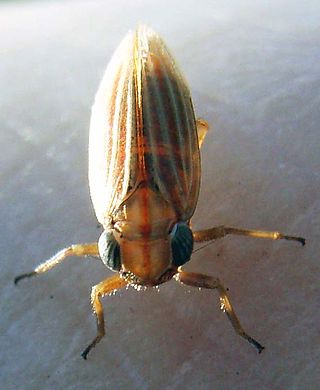
Delphacidae is a family of planthoppers containing about 2000 species, distributed worldwide. Delphacids are separated from other "hoppers" by the prominent spur on the tibia of the hindleg.

Flatidae are a family of fulgoroid planthoppers. They are cosmopolitan in distribution and are distinguished from others in the superfamily by a combination of characters. Like all other planthoppers, they suck phloem sap of plants. Some species are known to communicate with vibrations through the plant stems. Communication may be with mates, or with ants that tend the nymphs, protecting them and gathering honeydew secretions. Adults of some species have brightly coloured forewings which are tougher and known as tegmina unlike the membranous hindwings which are used for flight. Although a few can be identified by their coloration, most species requires dissection and examination under a microscope with access to literature on already described species.

Caliscelidae is a family of planthoppers, sap-sucking insects that belong to the order Hemiptera, suborder Auchenorrhyncha and superfamily Fulgoroidea. They are somewhat anomalous and have often been included within the family Issidae. Studies made in 2013 of the phylogeny of the Issidae and other groups using molecular techniques support the treatment of the group as a separate family. Sexual dimorphism can be marked. Some members of the family are called piglet bugs due to the shape of their snout. A particularly aberrant genus described in 2011 from India, Formiscurra, has males that resemble ants.

Delphacinae is a subfamily of delphacid planthoppers in the family Delphacidae. There are at least 1,700 described species in Delphacinae.

Achilidae is a family of planthoppers, sometimes called "achilids" in the order Hemiptera. There are at least 520 described species in Achilidae.

Asiracinae is a subfamily of delphacid planthoppers in the family Delphacidae. There are at least 30 genera and 180 described species in Asiracinae, which probably has a world-wide distribution.

Stenocranus is a genus of delphacid planthoppers in the family Delphacidae. There are more than 70 described species in Stenocranus.
Toya is a genus of delphacid planthoppers in the family Delphacidae. There are at least 40 described species in Toya.

Dictyopharinae is a subfamily of dictyopharid planthoppers in the family Dictyopharidae. There more than 100 genera and 500 described species in Dictyopharinae.

Meenoplidae is a family of fulgoromorph planthoppers that are closely related to the Kinnaridae. They are small, with tent-like wings and usually are less than a centimetre long and a little more than a 100 species in around 25 genera are known with a distribution restricted to the Old World. They are distinguished by having one or more of their claval veins covered in sensory pits along their length. The face is usually broad and the lateral carinae are strongly elevated. The last segment of the labium is elongate. A median ocellus is usually present. The wings are always present in adults and the venation consists of a small number of veins and very few cross veins. There are two subfamilies currently considered valid Meenoplinae and Kermesiinae. About 50 species are known from Africa. Along with the Achilixiidae and Kinnaridae, they have flattened star-shaped plate organs on their antennae. The nymphs are found close to the soil while adults feed mainly on monocots. Species identity can usually be established reliably only by examination of the male genitalia. A few species Phaconeura pluto, Meenoplus cancavus, Tsingya clarkei, and Suva oloimoa are known to be cave dwelling.

The Hemisphaeriinae are a subfamily of bugs in the family Issidae, based on the type genus Hemisphaerius. Species in 107 genera have been recorded in most continents, but the greatest diversity appears to be in South-East Asia.

The Flatinae are a subfamily of planthoppers, erected by Maximilian Spinola in 1839. Genera have been recorded from all continents except Antarctica: especially in tropical and subtropical regions.
Paralimnini is a tribe of leafhoppers in the subfamily Deltocephalinae. Paralimnini contains 139 genera and over 900 species divided into two subtribes: Aglenina and Paralimnina. The tribe has a cosmopolitan distribution.

Delphacini is an important tribe of planthoppers with a world-wide distribution.
Tropidocephala is a genus of planthopper bugs, typical of the tribe Tropidocephalini. Species have been recorded from Africa, Europe and Asia.

The Plectoderini are a large tribe of planthoppers in the family Achilidae, erected by Ronald Gordon Fennah in 1950. Genera have a world-wide distribution, but are hardly represented in Europe or northern Asia.














